2003 FORD ESCAPE fuel
[x] Cancel search: fuelPage 206 of 240
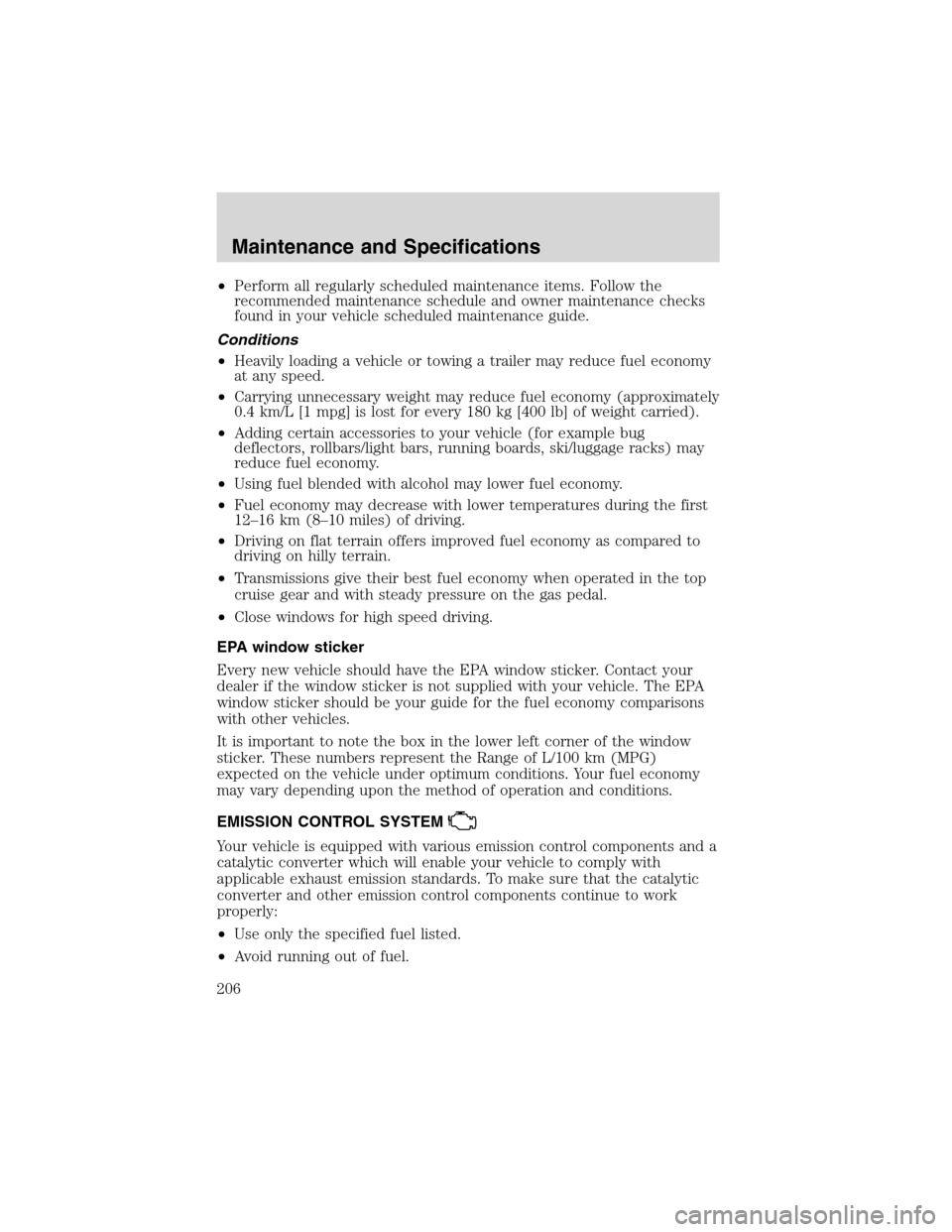
•Perform all regularly scheduled maintenance items. Follow the
recommended maintenance schedule and owner maintenance checks
found in your vehicle scheduled maintenance guide.
Conditions
•Heavily loading a vehicle or towing a trailer may reduce fuel economy
at any speed.
•Carrying unnecessary weight may reduce fuel economy (approximately
0.4 km/L [1 mpg] is lost for every 180 kg [400 lb] of weight carried).
•Adding certain accessories to your vehicle (for example bug
deflectors, rollbars/light bars, running boards, ski/luggage racks) may
reduce fuel economy.
•Using fuel blended with alcohol may lower fuel economy.
•Fuel economy may decrease with lower temperatures during the first
12–16 km (8–10 miles) of driving.
•Driving on flat terrain offers improved fuel economy as compared to
driving on hilly terrain.
•Transmissions give their best fuel economy when operated in the top
cruise gear and with steady pressure on the gas pedal.
•Close windows for high speed driving.
EPA window sticker
Every new vehicle should have the EPA window sticker. Contact your
dealer if the window sticker is not supplied with your vehicle. The EPA
window sticker should be your guide for the fuel economy comparisons
with other vehicles.
It is important to note the box in the lower left corner of the window
sticker. These numbers represent the Range of L/100 km (MPG)
expected on the vehicle under optimum conditions. Your fuel economy
may vary depending upon the method of operation and conditions.
EMISSION CONTROL SYSTEM
Your vehicle is equipped with various emission control components and a
catalytic converter which will enable your vehicle to comply with
applicable exhaust emission standards. To make sure that the catalytic
converter and other emission control components continue to work
properly:
•Use only the specified fuel listed.
•Avoid running out of fuel.
Maintenance and Specifications
206
Page 215 of 240
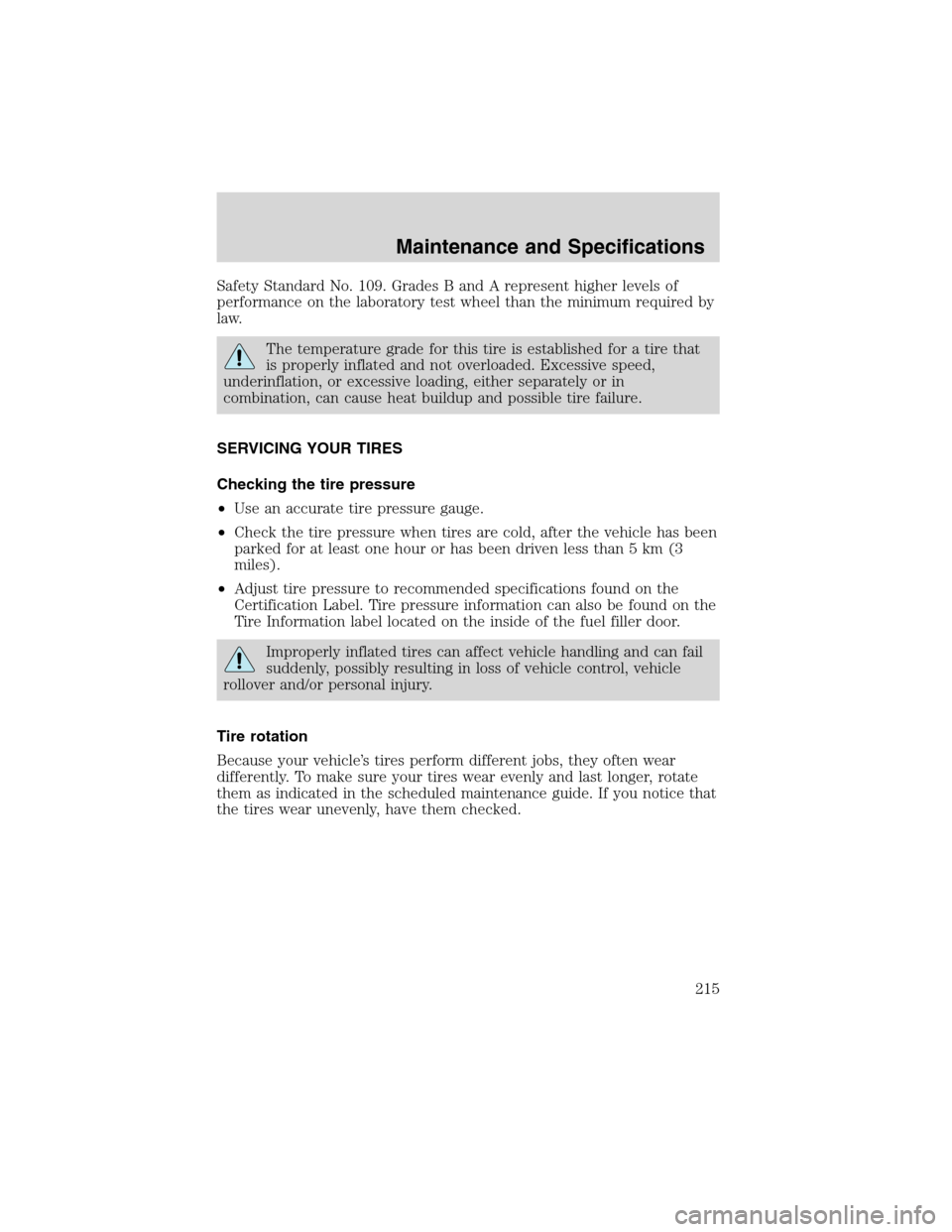
Safety Standard No. 109. Grades B and A represent higher levels of
performance on the laboratory test wheel than the minimum required by
law.
The temperature grade for this tire is established for a tire that
is properly inflated and not overloaded. Excessive speed,
underinflation, or excessive loading, either separately or in
combination, can cause heat buildup and possible tire failure.
SERVICING YOUR TIRES
Checking the tire pressure
•Use an accurate tire pressure gauge.
•Check the tire pressure when tires are cold, after the vehicle has been
parked for at least one hour or has been driven less than 5 km (3
miles).
•Adjust tire pressure to recommended specifications found on the
Certification Label. Tire pressure information can also be found on the
Tire Information label located on the inside of the fuel filler door.
Improperly inflated tires can affect vehicle handling and can fail
suddenly, possibly resulting in loss of vehicle control, vehicle
rollover and/or personal injury.
Tire rotation
Because your vehicle’s tires perform different jobs, they often wear
differently. To make sure your tires wear evenly and last longer, rotate
them as indicated in the scheduled maintenance guide. If you notice that
the tires wear unevenly, have them checked.
Maintenance and Specifications
215
Page 217 of 240
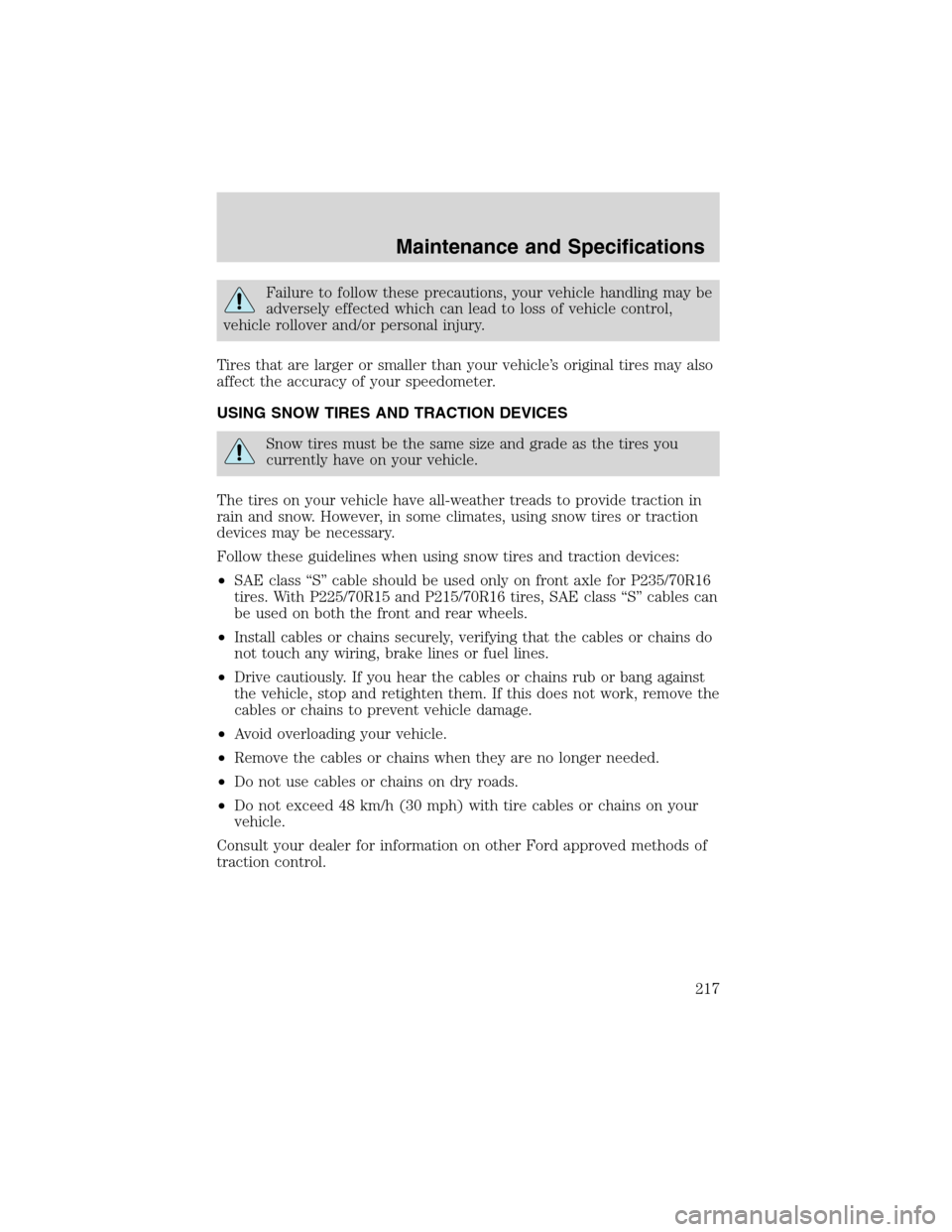
Failure to follow these precautions, your vehicle handling may be
adversely effected which can lead to loss of vehicle control,
vehicle rollover and/or personal injury.
Tires that are larger or smaller than your vehicle’s original tires may also
affect the accuracy of your speedometer.
USING SNOW TIRES AND TRACTION DEVICES
Snow tires must be the same size and grade as the tires you
currently have on your vehicle.
The tires on your vehicle have all-weather treads to provide traction in
rain and snow. However, in some climates, using snow tires or traction
devices may be necessary.
Follow these guidelines when using snow tires and traction devices:
•SAE class“S”cable should be used only on front axle for P235/70R16
tires. With P225/70R15 and P215/70R16 tires, SAE class“S”cables can
be used on both the front and rear wheels.
•Install cables or chains securely, verifying that the cables or chains do
not touch any wiring, brake lines or fuel lines.
•Drive cautiously. If you hear the cables or chains rub or bang against
the vehicle, stop and retighten them. If this does not work, remove the
cables or chains to prevent vehicle damage.
•Avoid overloading your vehicle.
•Remove the cables or chains when they are no longer needed.
•Do not use cables or chains on dry roads.
•Do not exceed 48 km/h (30 mph) with tire cables or chains on your
vehicle.
Consult your dealer for information on other Ford approved methods of
traction control.
Maintenance and Specifications
217
Page 218 of 240

MOTORCRAFT PART NUMBERS
Component 2.0L DOHC I4
Zetec engine3.0L DOHC V6 Duratec
engine
Air filter element
1FA-1683 FA-1683
Fuel filter FG-800-A FG-800-A
Battery BXT-96R BXT-40R
Oil filter FL-400S FL-820-S
PCV valve EV-244 EV-243
Spark plugs
2AZFS-32FE3AGSF-32W
1Failure to use the correct air filter element may result in severe engine
damage. The customer warranty may be voided for any damage to the
engine if the correct air filter element is not used.
2Refer to Vehicle Emissions Control Information (VECI) decal for spark
plug gap information.
3If a spark plug is to be removed for inspection, it must be reinstalled in
the same cylinder. If a spark plug needs to be replaced, use only spark
plugs with the service part number suffix letter as shown on the engine
decal.
REFILL CAPACITIES
Fluid Ford Part
NameApplication Capacity
Brake fluid
(clutch fluid, if
equipped)Motorcraft High
Performance
DOT 3 Motor
Vehicle Brake
FluidAll Fill to line on
reservoir
Engine oil
(including filter
change)Motorcraft SAE
5W-20 Premium
Synthetic Blend
Motor Oil2.0L I4 Zetec
engine4.25L
(4.5 quarts)
3.0L V6 Duratec
engine5.2L
(5.5 quarts)
Fuel tank N/A 2.0L I4 Zetec
engine61L
(16 gallons)
3.0L V6 Duratec
engine61L
(16 gallons)
Maintenance and Specifications
218
Page 221 of 240
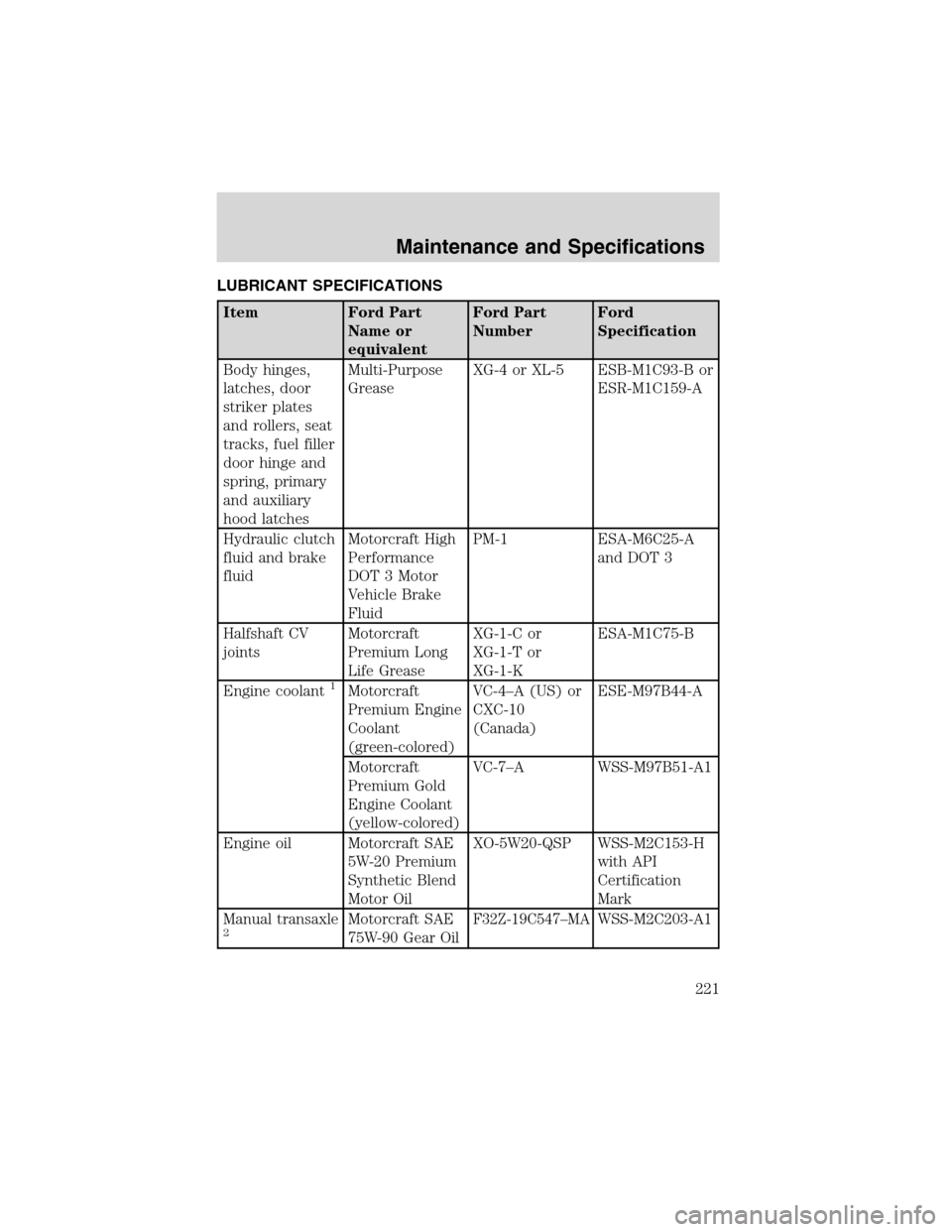
LUBRICANT SPECIFICATIONS
Item Ford Part
Name or
equivalentFord Part
NumberFord
Specification
Body hinges,
latches, door
striker plates
and rollers, seat
tracks, fuel filler
door hinge and
spring, primary
and auxiliary
hood latchesMulti-Purpose
GreaseXG-4 or XL-5 ESB-M1C93-B or
ESR-M1C159-A
Hydraulic clutch
fluid and brake
fluidMotorcraft High
Performance
DOT 3 Motor
Vehicle Brake
FluidPM-1 ESA-M6C25-A
and DOT 3
Halfshaft CV
jointsMotorcraft
Premium Long
Life GreaseXG-1-C or
XG-1-T or
XG-1-KESA-M1C75-B
Engine coolant
1Motorcraft
Premium Engine
Coolant
(green-colored)VC-4–A (US) or
CXC-10
(Canada)ESE-M97B44-A
Motorcraft
Premium Gold
Engine Coolant
(yellow-colored)VC-7–A WSS-M97B51-A1
Engine oil Motorcraft SAE
5W-20 Premium
Synthetic Blend
Motor OilXO-5W20-QSP WSS-M2C153-H
with API
Certification
Mark
Manual transaxle
2Motorcraft SAE
75W-90 Gear OilF32Z-19C547–MAWSS-M2C203-A1
Maintenance and Specifications
221
Page 223 of 240
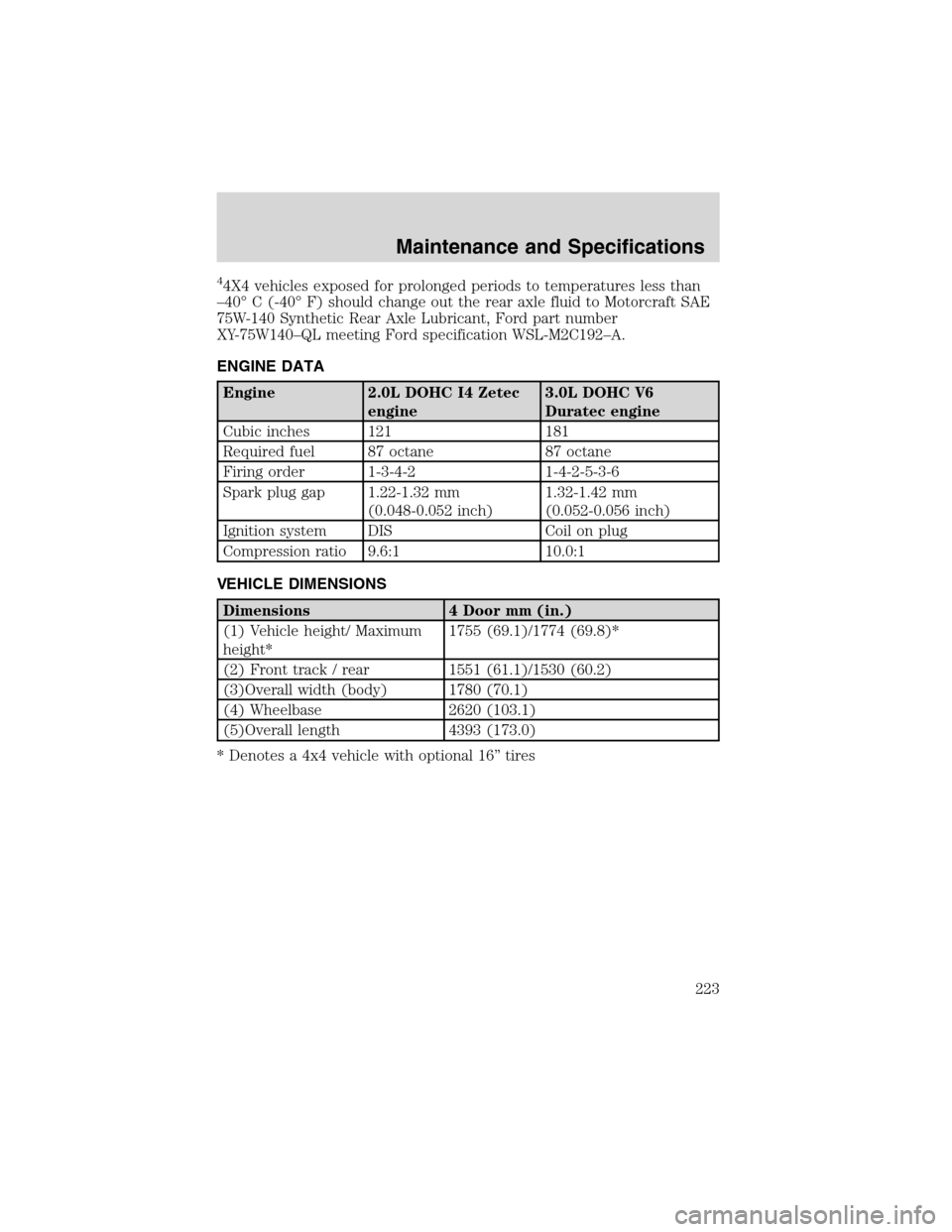
44X4 vehicles exposed for prolonged periods to temperatures less than
–40°C (-40°F) should change out the rear axle fluid to Motorcraft SAE
75W-140 Synthetic Rear Axle Lubricant, Ford part number
XY-75W140–QL meeting Ford specification WSL-M2C192–A.
ENGINE DATA
Engine 2.0L DOHC I4 Zetec
engine3.0L DOHC V6
Duratec engine
Cubic inches 121 181
Required fuel 87 octane 87 octane
Firing order 1-3-4-2 1-4-2-5-3-6
Spark plug gap 1.22-1.32 mm
(0.048-0.052 inch)1.32-1.42 mm
(0.052-0.056 inch)
Ignition system DIS Coil on plug
Compression ratio 9.6:1 10.0:1
VEHICLE DIMENSIONS
Dimensions 4 Door mm (in.)
(1) Vehicle height/ Maximum
height*1755 (69.1)/1774 (69.8)*
(2) Front track / rear 1551 (61.1)/1530 (60.2)
(3)Overall width (body) 1780 (70.1)
(4) Wheelbase 2620 (103.1)
(5)Overall length 4393 (173.0)
* Denotes a 4x4 vehicle with optional 16”tires
Maintenance and Specifications
223
Page 233 of 240
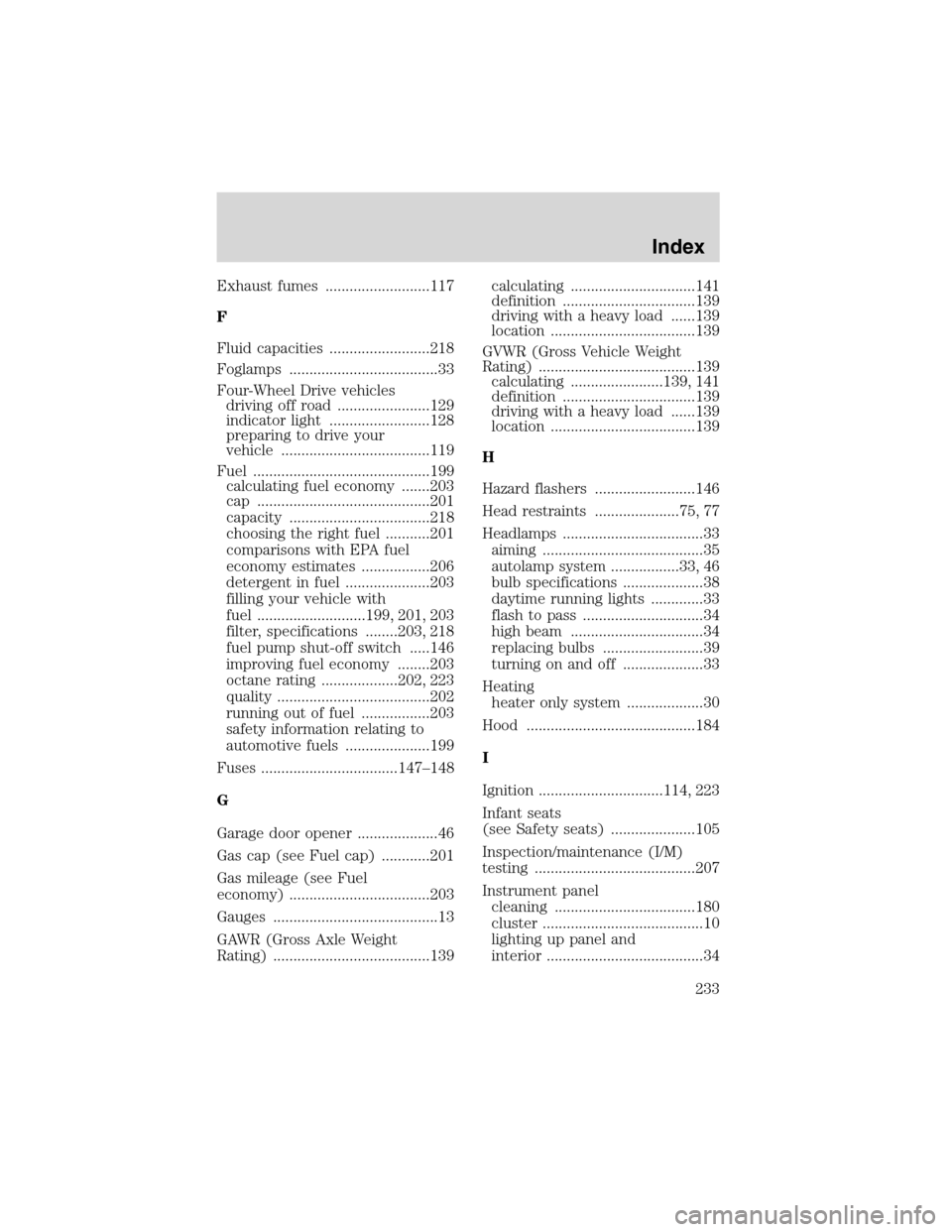
Exhaust fumes ..........................117
F
Fluid capacities .........................218
Foglamps .....................................33
Four-Wheel Drive vehicles
driving off road .......................129
indicator light .........................128
preparing to drive your
vehicle .....................................119
Fuel ............................................199
calculating fuel economy .......203
cap ...........................................201
capacity ...................................218
choosing the right fuel ...........201
comparisons with EPA fuel
economy estimates .................206
detergent in fuel .....................203
filling your vehicle with
fuel ...........................199, 201, 203
filter, specifications ........203, 218
fuel pump shut-off switch .....146
improving fuel economy ........203
octane rating ...................202, 223
quality ......................................202
running out of fuel .................203
safety information relating to
automotive fuels .....................199
Fuses ..................................147–148
G
Garage door opener ....................46
Gas cap (see Fuel cap) ............201
Gas mileage (see Fuel
economy) ...................................203
Gauges .........................................13
GAWR (Gross Axle Weight
Rating) .......................................139calculating ...............................141
definition .................................139
driving with a heavy load ......139
location ....................................139
GVWR (Gross Vehicle Weight
Rating) .......................................139
calculating .......................139, 141
definition .................................139
driving with a heavy load ......139
location ....................................139
H
Hazard flashers .........................146
Head restraints .....................75, 77
Headlamps ...................................33
aiming ........................................35
autolamp system .................33, 46
bulb specifications ....................38
daytime running lights .............33
flash to pass ..............................34
high beam .................................34
replacing bulbs .........................39
turning on and off ....................33
Heating
heater only system ...................30
Hood ..........................................184
I
Ignition ...............................114, 223
Infant seats
(see Safety seats) .....................105
Inspection/maintenance (I/M)
testing ........................................207
Instrument panel
cleaning ...................................180
cluster ........................................10
lighting up panel and
interior .......................................34
Index
233